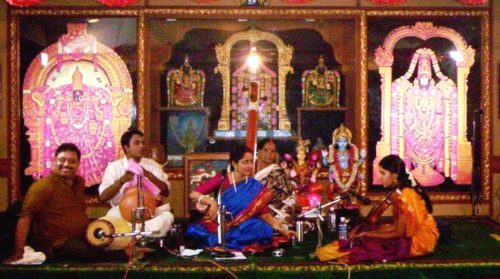The Difference between Hindustani and Carnatic Music
Origins
Hindustani classical music has its roots in Vedic traditions where hymns in Sama Veda, a sacred text, were sung rather than chanted and Carnatic music developed significantly during the Bhakti movement.
However, from the 12th Century, changes between Hindustani and Carnatic music began to occur due to Persian and Mughal influences in the north while Tamil Nadu, Kerala, Andhra Pradesh and Karnataka in the south of India see the development of the Carnatic Sangeet.
The Music
Raga and Tala
Raga and Tala form the basis of Indian music.Hindustani and Carnatic music may have the same ragas but the name of the ragas and the way they are performed is different.
There are 6 principal ragas and 10 modes or thaats in Hindustani music. In Carnatic music, there are seven notes to the scale which contain semitones and these come with melodic constraints. The Raga are organized into various modes known as melankara of which there are 72. The system for classifying ragas known as Melankara is attributed to Venkat Mukhi Swami. The ragas in Hindustani music comprise various bandish[i], which follow a set format and combination of notes. This does not allow much leeway for the composer. They are usually handed down from generation to generation.There is far more freedom in Carnatic music.
Carnatic music is written to be sung in a specific way. The singing style is of lesser importance in Hindustani music although there are several traditions of singing called gharanas which has its roots in ancient Hindu traditions.
Performance
Words
In Hindustani music, the language used is quite formal and words are not articulated clearly. The reason for this was that concerts usually occurred in muslim courts where reference to Hindu gods was underplayed in order to keep it a secret. In Carnatic songs the saints are revered and the words are very clear and well articulated. The meaning and pronunciation of the words is very important in conveying the mood of the performer.[ii]
Hindustani music is very particular about performing songs that refer to a particular time of day. If the words are about the afternoon, it will not be sung in the evening. There are no restrictions of this kind in Carnatic music.
Improvisation
Hindustani music has a particular format in the way music and improvisation is presented. This is less formal in Carnatic music.
Tempo
Hindustani music is very expressive and often in slower speeds with long note values, The music grows in intensity depending on the emotion the performer is trying to express.The speed in Carnatic music remains fairly constant and is generally in a fast tempo. The note values are also shorter.
Ornamentation
Hindustani music uses a fair amount of ornamentation and improvisation to develop the emotional aspect. The progression from one note to another is slow and smooth. In Carnatic Music there are fast oscillations between two notes. The music is less intense and does not use as much ornamentation. It is more spiritual and intellectual.
Instruments
Instruments that are used in Hindustani music include the tabla, sarangi, sitar, santoor, and clarinet as opposed to the Carnatic music which uses the veena, mridangam, mandolin, and jalatarangam.
The violin and flute are common in both. Because Carnatic music is mainly vocal, a melody played on an instrument it is done in a singing style.
| Hindustani | Carnatic | |
| Origins | North | South |
| Vedic tradition | Bhakti tradition | |
| Raga | 6 principal ragas known as bandish and 10 modes or thaats. | Scales of 7 notes containing semitones
and 72 modes or melankara. |
| Style | Gharanas singing style. | More vocal style even when played by instrument. |
| Words | Formal and not clearly articulated. | Words important in order to express emotion. |
| Improvisation | Specific format as to how improvisation takes place. | Improvisation is less restricted. |
| Tempo | Slow with long note values increasing in intensity. | Faster tempo that remains more constant with shorter note values. |
| Ornamentation | Ornamentation is used to enhance the emotion. | There is an oscillation between the notes to create a spiritual and more intellectual performance. |
| Instruments | Tabla, sarangi, sitar, santoor, and clarinet. | Veena, mridangam, mandolin, and jalatarangam. |
- The Difference between Hindustani and Carnatic Music - August 15, 2017
Search DifferenceBetween.net :
5 Comments
Leave a Response
References :
[0][i]http://www.thehindubusinessline.com/blink/watch/what-is-a-bandish/article6573940.ece
[1][ii]http://www.sruti.org/library/Thyagaraja/1995/TAS1995(Part2).pdf
[2]http://globalmusic.wikispaces.com/Ethnomusicology?responseToken=fea01143e96bcead821c080812ee0bbd
[3]https://commons.wikimedia.org/wiki/File:A_Lady_Playing_the_Tanpura,_ca._1735.jpg



i’m empressed bacause my grades got high when i research on this web.
cool subscribe to t series
how dare you oppose me mortal
cool subscribe to t series
There is lot of wrong info regarding origin and scope for improvisation. It us the other way around. Also regarding tempo, carnatic music is so eloborative, and has range of all speeds. It has documented origin since 2nd century.